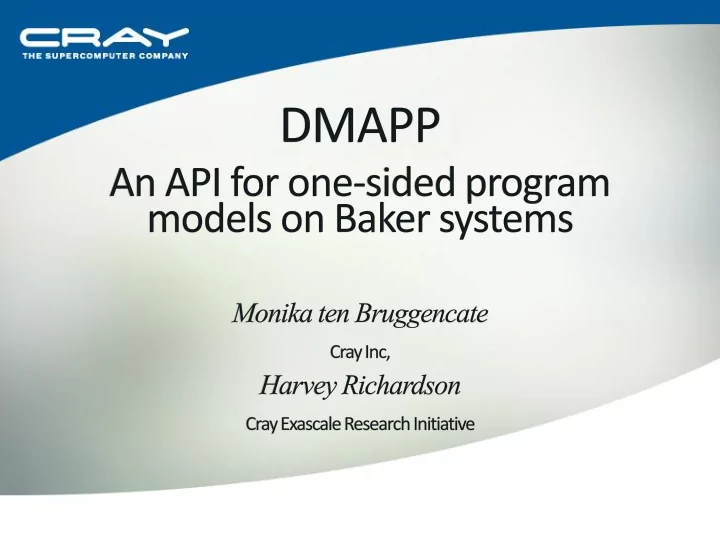

DMAPP in context Basic features of the API Memory allocation and sample API calls Preliminary Gemini performance measurements 2
The Distributed Memory Application (DMAPP) API Supports features of the Gemini Network Interface Used by higher levels of the software stack: PGAS compiler runtime SHMEM library Balance between portability and hardware intimacy Intended to be used by system software developers Application developers should use SHMEM 3
Apps PE MPICH2 MPICH2 Cray SHMEM Cray SHMEM PGAS compilers PGAS compilers user-level GNI DMAPP kernel Linux Core kernel-level GNI Gemini HW Abstraction Layer Gemini HW Abstraction Layer HW Gemini network processor Gemini network processor 4
Distributed memory model One-sided model for participating (SPMD) processes launched by Alps aprun command Each PE has local memory but has one-sided access (PUT/GET) to remote memory Remote memory has to be in an accessible memory segment 5
PE PE put source destination Network supports direct remote get/put from user process to user process. Mechanisms: Block Transfer (BTE) Fast Memory Access (FMA) including Atomic Memory Operations (AMOs) 6
process Remote op segments Remote source or destination in either data or symmetric-heap segments Symmetry means we can use local address information in remote context 7
dmapp_init Sets up access to data and symmetric heap (exports memory) barrier you can set or read available resource limits dmapp_get_jobinfo Returns a structure with useful information: Number of PEs Index of this PE Pointers to data and symmetric heap segments required in other calls 8
dmapp_put(*target_addr, *target_seg, target_pe, source_addr, nelems, type) Remote locations defined by: address, segment, pe This is a blocking operation type can be DMAPP_{BYTE,DW,QW,DQW) for 1, 4, 8 and 16 bytes. Analogous get call 9
Blocking (no suffix) dmapp_put , dmapp_get Non-blocking explicit (_nb suffix) dmapp_put_nb (…, syncid) Non-blocking implicit (_nbi suffix) No handle to test for completion Synchronization (memory completion/visibility) Can wait on specific syncid Can wait for all implicit operations to complete 10
iput put Remote data Strided calls dmapp_iput …, dmapp_iget … Additional arguments define source and destination stride in terms of elements 11
ixput put Remote data Scatter/Gather calls dmapp_ixput …, dmapp_ixget … Local data is contiguous Remote data is distributed as defined by an array of offsets 12
put_ixpe PE 0 PE 1 put PE 2 nelems =3 Put with indexed PE-stride calls dmapp_put_ixpe …, dmapp_get_ixpe … Local data is contiguous Remote data is distributed (as defined by an array of PE-offsets) to the same address on each PE Use for small amounts of data These are not collective operations 13
scatter_ixpe PE 2 PE 4 put PE 6 nelems =1 Scatter/Gather with indexed PE-stride calls dmapp_scatter_ixpe , dmapp_gather_ixpe Local data is contiguous Source is scattered to (or gathered from) PEs nelems elements at a time. 14
Atomic operations to 8-byte (QW) remote data Command Operation AADD Atomic ADD AAND Atomic AND AOR Atomic OR AXOR Atomic EXCLUSIVE OR AFADD Atomic fetch and ADD AFAND Atomic fetch and AND AFOR Atomic fetch and OR AFXOR Atomic fetch and XOR AFAX Atomic fetch AND-EXCLUSIVE OR ACSWAP Compare and SWAP 15
AADD AFADD t Direct support in NIC Be careful to only read values via DMAPP API 16
Some calls return syncid (_nb) Can test or wait on completion dmapp_syncid_wait(*syncid) dmapp_syncid_test(*syncid,*flag) For implicit non-blocking (_nbi) dmapp_gsync_wait() Dmapp_gsync_test(*flag) Use for many small messages 17
DMAPP applications can allocate memory in symmetric heap double *a; a=(double*) dmapp_sheap_malloc(N*sizeof(double)); Associated realloc and free calls. Application is responsible for maintaining symmetry of allocations 18
DMAPP exports data and symmetric heap for you This means: For C File scope and static inside function Allocated in symmetric Heap For Fortran (no API but if there was) SAVEd data Data in COMMON 19
PE PE PE PE PE +1 AA +1 +1 +1 +1 Barrier counter PE Atomic add for master counter (FADD for testing) Master compares (with n-1) and swaps with 0 … master releases other PEs 20
static uint64_t barrier_counter, bc; if (mype==master){ do{ // wait until counter is npes-1, swap with 0 dmapp_acswap_qw(&bc,(void *)&barrier_counter, seg_data,mype,npes-1,0); } while ( bc!=(npes-1)); } else { dmapp_aadd_qw((void*)&barrier_counter,seg_data, master,1); } // now release barrier… 21
SHMEM Has same SPMD model Requires use of symmetric memory Original interface is blocking Non-standard extensions for non-blocking put/get Varying-sized data items with typed API Get/put with strided and gather/scatter variants Barrier and collective operations on sets of PEs Has the same atomic memory operations SHMEM is implemented using DMAPP for Gemini systems 22
Data measured on prototype system during Q1 2010 2100MHz Opteron processors 2400MHz HyperTransport interface Dual node tests run between PEs on neighbouring Gemini routers 23
2.5 PUT, ping-pong PUT, at source 2.0 GET Time (microsecs) 1.5 1.0 0.5 0.0 8 16 32 64 128 256 512 1024 Size (bytes) 24
7000 6000 PPN=1 Bandwidth (mbytes/sec) PPN=2 5000 PPN=4 4000 3000 2000 1000 0 8 16 32 64 128 256 512 1024 2K 4K 8K 16K 32K 64K Element size (bytes) 25
3000 2500 Bandwidth (mbytes/sec) 8 bytes 2000 64 bytes 256 bytes 1500 1000 500 0 1 2 4 8 16 32 64 Non-blocking puts 26
160 Vector length = 16 140 Vector Length = 64 Vector length = 4096 120 Rate (millions/sec) 100 80 60 40 20 0 2 4 8 16 32 64 128 256 512 1024 2048 4096 Stride (64-bit words) 27
120 100 1 AMO 8192 AMOs AMO rate (millions) 80 60 40 20 0 0 256 512 768 1024 Number of processes 28
Latency (~1 s) far better than SeaStar Good aggregate bandwidths on small transfers High AMO rates, especially when multiple processes target the same variables Strided puts are an important case for CAF Ongoing optimization effort (for example reduce number of FMA descriptor updates) 29
What is DMAPP and where does it fit? Basic features of the API Memory allocation and sample API calls Preliminary Gemini performance data 30
Recommend
More recommend